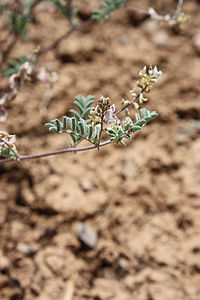
Photo from wikipedia
Abstract The characteristic vegetation structure of arid savannas with a dominant layer of perennial grass is maintained by the putative competitive superiority of the C4 grasses. When this competitive balance… Click to show full abstract
Abstract The characteristic vegetation structure of arid savannas with a dominant layer of perennial grass is maintained by the putative competitive superiority of the C4 grasses. When this competitive balance is disturbed by weakening the grasses or favoring the recruitment of other species, trees, shrubs, single grass, or forb species can increase and initiate sudden dominance shifts. Such shifts involving woody species, often termed “shrub encroachment”, or the mass spreading of so‐called increaser species have been extensively researched, but studies on similar processes without obvious preceding disturbance are rare. In Namibia, the native herbaceous legume Crotalaria podocarpa has recently encroached parts of the escarpment region, seriously affecting the productivity of local fodder grasses. Here, we studied the interaction between seedlings of the legume and the dominant local fodder grass (Stipagrostis ciliata). We used a pot experiment to test seedling survival and to investigate the growth of Crotalaria in competition with Stipagrostis. Additional field observations were conducted to quantify the interactive effect. We found germination and growth of the legume seedlings to be facilitated by inactive (dead or dormant) grass tussocks and unhindered by active ones. Seedling survival was three times higher in inactive tussocks and Crotalaria grew taller. In the field, high densities of the legume had a clear negative effect on productivity of the grass. The C4 grass was unable to limit the recruitment and spread of the legume, and Crotalaria did outcompete the putative more competitive grass. Hence, the legume is able to spread and establish itself in large numbers and initiate a dominance shift in savannas, similar to shrub encroachment.
Journal Title: Ecology and Evolution
Year Published: 2018
Link to full text (if available)
Share on Social Media: Sign Up to like & get
recommendations!